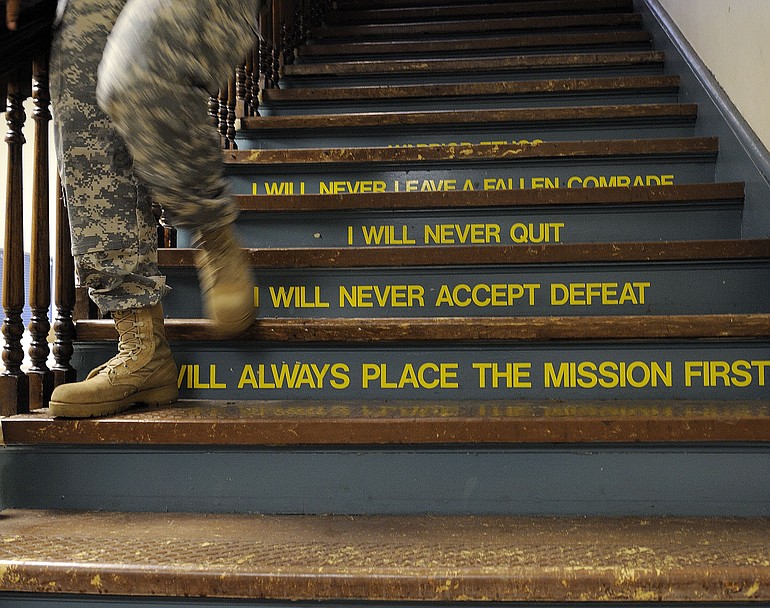Each stair in this U.S. Army Reserve administration building on the Fort Vancouver National Site carries a message for a boot-clad foot — and the soldier attached to it.
Left foot: “I will never accept defeat.” Right foot: “I will never quit.” Left foot: “I will never leave a fallen comrade.” Up it goes to the top.
The better part of two centuries of military history permeate every inch of the 366-acre Fort Vancouver National Site. But it is on the 33 acres of the East and South Barracks that the Army — in the form of the 104th Reserve Division — still physically remains.
But not for much longer.
The Army, under orders by Congress, will be dispersed to Fort Lewis and to a new reserve recruiting center east of Orchards by September 2011. It’ll be up to a different branch of the federal government, the National Park Service, to keep the East and South Barracks going strong.
The Army’s been holding down the fort, waiting for its next deployment, in the dozens of wooden buildings constructed in the early 1900s. Like anyone with plans to leave a place, some of the maintenance work has been deferred.
To step onto the front porch of building 989 — the middle of three U-shaped former soldier barracks on McClellan Road — is to be greeted by chipping paint and a deck that’s obviously been trodden upon by many a boot. Lead, asbestos and electrical issues are all present. Seismic and disability access upgrades are also necessary. The story’s the same in nearly every other structure.
Getting them up to par could cost tens of millions of dollars. At this point, it’s unclear which federal agency will pay for what.
While officials from both the Park Service and Army are sure they’ll hand off the buildings without a war, there’s sure to be a few battles.
The Park Service is in the middle of a $500,000 analysis that will let the agency “get a feel for how big the problem is,” said Ray Cozby, project manager with the Park Service, which also manages historic Fort Vancouver, established by the Hudson’s Bay Company in 1824. “All the utilities in the East Barracks are beyond repair.”
“What we haven’t got is a commitment to a specific level of work,” Cozby said. “They acknowledge a responsibility, but where does it fall into the scheme?”
When the Army left the West Barracks buildings to the city of Vancouver in 1999, some of the mitigation for lead or asbestos was done with a bit of a scorched earth method.
In the Artillery Barracks, for example, a park historian noted they took a pressure washer to the original tin tiles on the ceilings to remove the lead paint, which in turn is causing them to corrode.
This time around, the Army has agreed not to do that — but they may also not do as much as the Park Service would like.
“My guidelines, from the Secretary of the Army, are to attack issues of safety, environment and sustainment,” said Bill Schell, a civilian facility management specialist with the 88th Regional Support Command. “Anything beyond that is a decision at a higher level.”
Elson Strahan, CEO and president of Fort Vancouver National Trust, the nonprofit that administers the city-owned West Barracks, said he hopes to see the Army do the bulk of the fixing up.
The land “should not come with a huge economic burden for the Park Service,” Strahan said. “One federal agency shouldn’t leave the debt to another.”
Sgt. Paul Edwards, a spokesman for the Army based in Seattle, said that’s not the plan. “We won’t kick back those problems to whoever takes (the barracks) over,” he said.
Not that the Park Service doesn’t have big plans of its own: The agency is crafting a master plan for the East and South Barracks, where all the buildings were built between 1903 and about 1990. The South Barracks is home to the newer structures, many of which will continue their current use as storage facilities and garages.
Based on public input — and the idea that historical preservation and open access will take priority — Cozby said there’s a number of ideas for what to do with the site. The building where the 104th administrative offices are could be turned into Park Service and other federal offices. Other spots, however, could become a museum, a large community hall, retail shops and restaurants.
That will also take money, Cozby conceded, but added the transformation will likely be done in phases, not in one massive overhaul.
The results of the master plan should also factor into the Army and Park Service negotiations, Strahan said.
“Part of the negotiations and discussions are not only what they’ll do now, but how much they do based on future use,” he said.
The Fort Vancouver National Trust and the Park Service are discussing creating an arrangement similar to that between the nonprofit and the city of Vancouver in the West Barracks and Officers Row, where the Park Service would own the land but the trust would act as the manager, developer and landlord, along with taking care of other day-to-day functions.
Schell, who has long worked to help care for the buildings in the East and South Barracks, said he is excited to see what becomes of his workplace.
“It’s a good, positive move for the Park Service to take the property,” he said. “With all the architecture and history, I believe they’ll do a great job taking on the Vancouver Barracks.”
There’s nostalgia amongst the men and women who serve there, but they also accept their marching orders.
“I’ve been here for 25 years, I love the Vancouver Barracks,” Schell said. “But soldiers, as you know, are mobile, gung-ho and very adaptable.”



